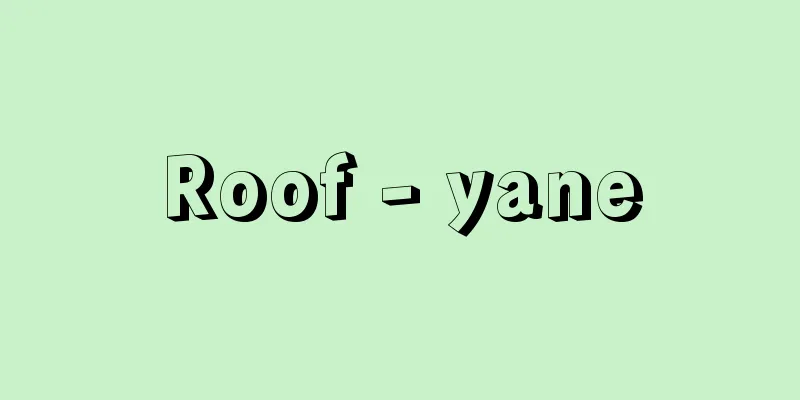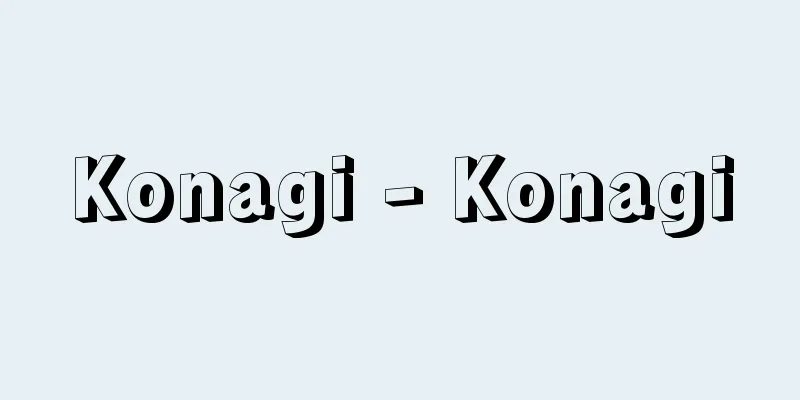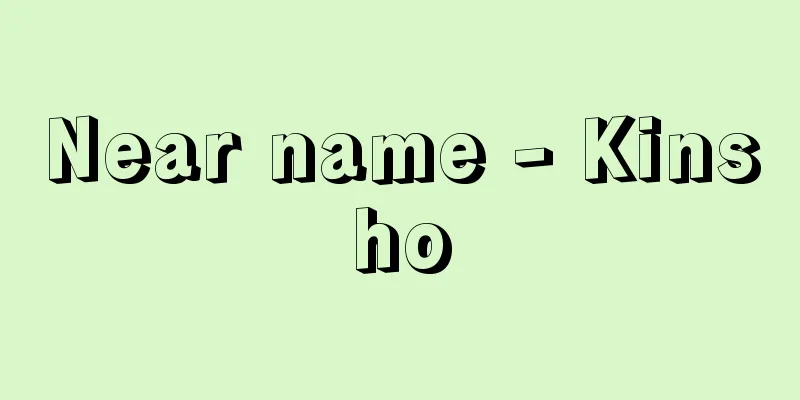Roof - yane

|
It covers the upper part of a building and separates the living space from the outside world. In the narrow sense, it refers to the upper surface finishing material (roofing material) and its underlying part, and in the broad sense, it includes the trusswork that supports it, but here we will explain the roof in the narrow sense. The roof does not simply protect against rain and dew, but, together with the walls and floors, it also encloses the architectural space, so it must also block heat, sound, and lines of sight, and be safe from damage caused by falling objects. Since it is exposed to the outside along with the walls, it is also an important element in determining architectural design. In particular, in areas with a lot of rain, such as Japan, roofs have to be built with a natural slope, and the eaves are deep to protect the walls and openings from rainwater, so the roof becomes extremely conspicuous. In other words, the reason why Japanese buildings are called "roof architecture" in contrast to European "wall architecture" is that a special construction method was developed independently that combines a plain roof and decorative eaves to make the roof slope steep and to prevent the eaves from becoming too low even if the eaves are deep. In ordinary buildings, the roof is supported by the structure, is treated as a dead load structurally, and is usually clearly distinguished from the walls in terms of design. However, in buildings with domes or vault roofs, or buildings with a Schaerlen structure, the walls and roof are constructed as one unit, and the boundary between the two is not clear. In such cases, the roof plays an important structural role by connecting the walls together. [Yamada Koichi] shapeRoofs are broadly divided into flat roofs and pitched roofs. Flat roofs are horizontal roofs (they can have a very gentle slope of 1/100 to 5/100), and were originally used in places with little precipitation. In desert areas such as the Middle East, simple flat roofs are commonly seen, consisting of horizontal tree branches and soil placed on top. However, advances in waterproofing materials have made them suitable for use in areas with a lot of rain, such as Japan. However, compared to pitched roofs, flat roofs are more likely to leak, and care must be taken when applying them to wooden buildings. Flat roofs are commonly called rooftops in Japan, and those that can be walked on are called walking floors, while those that cannot are called non-walking floors. The finishing materials for each are different, but in either case they are both horizontal surfaces, and walking floors in particular have parapets (handrail walls found on roofs and open-ceiling corridors) or handrails around them, making them even less noticeable from the outside, so they do not pose much of a problem in terms of architectural design. The shape of a sloped roof is determined based on the amount of rainfall in the area, the structure of the building, the design and function, and can be varied in countless ways depending on the roofing (finishing) materials used. Well-known types include single-slope, maneki, gable, half-gable, hipped, gambrel, square, koshiore, mansard, cone, dome, vault and sawtooth, but overhanging and ridgepole roofs can also be used as needed. The slope of a roof is naturally steeper in areas with a lot of rain and gentler in areas with little rain, but in areas with heavy snowfall, it is often made gentler due to the need to store snow on the roof surface (a layer of snow is effective for insulation and also to avoid the risk of slipping off unexpectedly). It is also natural that roofing materials with low water permeability (e.g. metal sheets) will result in looser roofs, while materials with large water permeability (e.g. straw) will result in steeper roofs. In Japan, the most common roof shapes are gabled, hipped, and gambrel roofs, with different shapes being used depending on the nature of the building. For example, the highest-class buildings up until the Nara period (such as the Daigokuden in palaces and the Kondo in temples) were hipped roofs, while high-class buildings thereafter were gambrel roofs, and gabled roofs were more common in ordinary buildings. However, it goes without saying that a square roof is more suitable for a building with a square plan, and a cone roof for a circular plan. Additionally, soffits and mansards allow the attic to be used for rooms, and are shapes commonly seen in Western-style architecture. Domes and vaults are roof shapes derived from arch construction, but are not familiar in Japan, which does not have a tradition of masonry architecture. Sawtooth roofs are used in factory buildings because the vertical sides face north and this is convenient for keeping the direction of sunlight constant throughout the day. However, they also create long valleys, which increases the risk of water leakage. [Yamada Koichi] Structure and MaterialsFor flat roofs, a continuous impermeable coating is used to create a waterproof layer to keep out water. For walkable floors, a protective layer is placed on top of the waterproof layer, but for non-walkable floors, no protective layer is placed, making what is called exposed waterproofing. Generally, exposed waterproofing is less durable, but once broken, it is easier to repair than those with a protective layer. Coating materials include asphalt, synthetic resin, metal film, and waterproof mortar. All of these are usually used to cover concrete or mortar surfaces, but it is considered preferable to use a flexible material that can adapt to minor cracks in concrete. Asphalt waterproofing is made by bonding paper impregnated with the material (asphalt roofing) with molten asphalt as an adhesive, and is still considered the most reliable waterproofing layer today, but it is difficult to withstand heat, so it is usually used in conjunction with a protective layer. Synthetic resin is available in both coated and sheet form, and is said to be lightweight and highly waterproof, and can be used for both exposed and non-exposed types. Metal membranes are created by applying aluminum powder and are often used as a covering for other exposed waterproofing. Waterproof mortar is applied by applying dense cement mortar mixed with waterproofing agents, but it is difficult to achieve complete waterproofing with this alone, so it is usually used in combination with other waterproofing layers. The protective layer is usually made by pouring lightweight concrete over the above coating, and then finishing it with tiles and mortar, but sometimes removable blocks are placed on top to make it easier to repair the coating. Thatching materials for sloped roofs include vegetable-based grass, thatch, straw, shingles, cypress bark, and boards, as well as mineral-based materials such as fired clay roof tiles, natural slate, asbestos slate, cement tiles, and metal sheets, and the structure of the base varies depending on the type. With vegetable-based materials, lattices are laid horizontally perpendicular to the rafters, and the roofing material is layered on top of them. With mineral-based materials, a backing board is attached to the rafters, and the roofing material is placed on top of that. In either case, great care is taken to prevent the roofing material from sliding down the slope. Grass, thatch, and straw are still used on farms, and were common roofing materials in the old days when clay tiles and other materials were not yet common. Kashi is made by cutting relatively water-resistant wood such as cypress or maki into thin strips and layering them with bamboo nails, while hinoki bark is layered with cypress bark and has been used for shrines, temples, and palaces. When cedar bark is used instead of cypress, it is called cedar bark roofing. Board roofing involves placing boards directly on the rafters, and stones are sometimes placed on top of them to prevent them from flying away in the wind. These plant-based materials have excellent heat retention and are not susceptible to frost damage, but they are not very durable, especially not fire-resistant, so their use in urban areas is currently prohibited by the Building Standards Act, except in special cases such as cultural property buildings. Furthermore, since plant materials, especially grass and straw, are prone to allowing water to pass through even when laid quite thickly, roofs made using these materials are naturally built with a steep slope. Clay tiles are broadly classified into smoked and glazed tiles in terms of material, and into tile, real tile, S-type, Spanish type, etc. in terms of shape. All are made by molding clay and firing it in a kiln, but glazed tiles have the advantage of being able to be colored freely and have a lower water absorption rate. However, smoked tiles are generally preferred in Japanese-style architecture, and the silver-gray wavy tiles are a seasonal feature decorating the streets of old Japan, and are the most familiar and trusted by Japanese people through their use for over a thousand years. The standard method of roofing for each clay tile is to first lay a thin board on the backing board, then place roofing soil on top of that and then place the tile on top. However, in order to reduce weight, some tiles do not use boards or roofing soil, but instead have waterproof paper (asphalt felt) laid on the backing board, and then have boards on which the tiles are hung. This type of board is called a hooked board. In either case of using roofing soil or battens, the tiles may be secured in place with copper nails or copper wire if necessary. Natural slate is made by cutting thin slate sheets into a set shape and laying them on top of a backing board and waterproof paper. It was popular for the roofs of red brick buildings in the Meiji period and usually has a scaly finish. Asbestos slate is a molded sheet made by hardening asbestos with cement, and comes in corrugated and flat sheets, but is not often used for high-end buildings. Cement tiles are made by molding cement into a clay tile shape, and are used in much the same way, but are also not used for high-end buildings. Metal sheets include galvanized steel sheets, colored steel sheets, and copper sheets. Galvanized steel sheets come in corrugated and flat types, but they require frequent repainting of anti-rust paint, and in recent years have only been used for temporary buildings, and are being replaced by colored steel sheets. Colored steel sheets are steel sheets with paint baked onto them in advance, and are considered to be more reliable in terms of rust prevention than painting on the construction site. Copper sheets are the highest quality metal sheet material, with excellent durability, and those with verdigris sprouts have a unique look. Colored steel sheets and copper sheets are made from flat sheets, and are laid on a backing board covered with waterproof paper. There are two types of roofing: flat roofing and tile roofing. Flat roofing is a method of laying the roof flat as shown on the backing board, while tile roofing is a method of nailing battens at regular intervals along the slope and then covering the battens with boards, and the latter is said to have less risk of leaks. In either case, the edges of the plates must be folded to make seam joints, and with colored steel plates, the paint can peel off in these areas, which can lead to rust. Copper plates do not have this problem, and in that sense they are the highest quality material. [Yamada Koichi] [Reference items] | | | | |©Shogakukan "> Names of the parts of a sloped roof ©Shogakukan "> Roof type and shape The south spire of Chartres Cathedral. Spires are common in Gothic cathedrals. Chartres, France ©Shogakukan "> Overseas roof styles (1) The Renaissance dome of St. Peter's Basilica has a cupola diameter of 42 metres. Stone ribs support the crowned spire. Vatican City ©Shogakukan "> Overseas roof styles (2) The leek dome seen in Basil's Cathedral. This is a type seen in the late Byzantine style. Moscow, Russia ©Shogakukan "> Overseas roof styles (3) The Indo-Islamic dome of the Taj Mahal. Both the interior and exterior are finished in white marble. India, Suburbs of Agra ©Shogakukan "> Overseas roof styles (4) Wooden buildings in China. Chinese buildings, which are the birthplace of traditional wooden architecture that is commonly seen throughout East Asia, are characterized by curved roofs and curved eaves. The photo shows the Wumen Gate, the main gate of the Forbidden City. Beijing, China ©Shogakukan "> Overseas roof styles (5) Source: Shogakukan Encyclopedia Nipponica About Encyclopedia Nipponica Information | Legend |
|
建物の上方を覆って外界から居住空間を区画するもの。狭義には上面仕上げ材(屋根葺(ふ)き材)とその下地部分をさし、広義にはそれを支える小屋組みを含むが、ここでは狭義の屋根について説明する。 屋根は単に雨露を防ぐだけでなく、壁、床とともに建築空間を囲うものであるから、熱、音、視線などを遮り、かつ落下物などによる破壊に対しても安全でなければならない。また壁とともに外部に露出しているから、建築意匠を決定する重要な要素でもある。とくに日本のように多雨の地域では、おのずから勾配(こうばい)をもつ屋根をつくらざるをえず、さらに壁面や開口を雨水から保護するために軒の出が深くなり、したがって屋根はきわめて目だつ存在となる。すなわち、ヨーロッパ系の「壁の建築」に対し、日本の建物が「屋根の建築」と称されるゆえんで、屋根の勾配を急にし、しかも軒の出を深くしても軒先が低くならないように、野(の)屋根と化粧軒を組み合わせる特殊な構法も独自に開発された。 一般の建物では屋根は躯体(くたい)に支えられるもので、構造的には死荷重の扱いを受け、意匠的には壁と画然と区別されるのが普通である。しかしドームやボールト屋根をもつもの、またはシャーレン構造のような建物では壁体と屋根が一連のものとしてつくられ、両者の境界も明瞭(めいりょう)でない。このような場合には、屋根はかえって壁体を相互に緊結するものとして構造上も重要な役割を担うことになる。 [山田幸一] 形状屋根は陸(ろく)屋根と勾配屋根とに大別される。陸屋根は水平な屋根(水垂(みずた)れ勾配、すなわち1/100~5/100程度のきわめて緩い傾斜はつけられる)で、もともと降水量の少ない所で用いられたもので、中近東などの砂漠地帯では木の枝を水平に架し、その上に土をのせただけの簡単な陸屋根がごく普通にみられる。しかし防水材料の進歩によって、日本のような多雨地帯でも採用できるようになった。ただし勾配屋根に比し雨漏れの危険の多いことは否めず、とくに木造建築に適用する場合は注意を要する。陸屋根は日本では俗に屋上とよばれ、その上を歩行できるようにしたものを歩行床、そうでないものを非歩行床といい、それぞれ仕上げ材料が異なるが、いずれにせよ水平面であることに変わりなく、とくに歩行床では周囲にパラペットparapet(屋上や吹抜け廊下にみられる手すり壁)や手すりが設けられ、外観ではさらに目だたなくなるから、建築意匠上はそれほど問題とならない。 勾配屋根の形状は、その土地の降水量、建物の構造、意匠または機能などの要請に基づいて決定され、さらにそのうえに葺き(仕上げ)材料の相違が加わって千変万化する。よく知られているものに、片流れ、招き、切妻(きりづま)、半切妻、寄棟(よせむね)、入母屋(いりもや)、方(宝)形、腰折(こしおれ)、マンサード、円錐(えんすい)、ドーム、ボールト、鋸(のこぎり)形があるが、必要に応じて差掛け、越(こし)屋根などの設けられることもある。勾配は多雨地帯で急に、寡雨地帯で緩になるのが自然であるが、積雪地帯では屋根面に雪を蓄えておく必要(雪の層は断熱に有効。また不時に滑り落ちる危険を避けなければならない)から緩にすることが多い。また葺き材料に透水性の小さいもの(例、金属板など)を用いれば緩に、大きいもの(例、藁(わら)など)を用いれば急になるのも当然である。日本で一般的な形状は切妻、寄棟、入母屋で、建物の性格によって使い分けられる。たとえば奈良時代までの最高級建物(宮殿における大極殿(だいごくでん)、寺院における金堂など)では寄棟、その後の高級建物では入母屋が、通常の建物では切妻が多い。しかし方形平面の建物では方形が、円形平面では円錐が都合のよいことはいうまでもない。また腰折、マンサードは屋根裏を居室などにあてることができ、洋風建築によくみられる形状である。ドーム、ボールトはアーチ構法から導き出される屋根形であるが、組積式建築の伝統をもたない日本ではなじみは薄い。鋸屋根は垂直面を北面させ、終日光線方向のかわらぬようにするのに便利で、工場建築に用いられるが、反面、長い陸谷(ろくだに)をつくるので漏水の危険が多い。 [山田幸一] 構造と材料陸屋根では連続した不浸透性被膜で防水層をつくって水を遮断する。歩行床の場合は防水層の上に保護層を置くが、非歩行床の場合は置かず、いわゆる露出防水にすることもある。一般に露出防水は耐久性に劣るが、いったん故障をおこした場合の修理は保護層のあるものに比し容易である。被膜材料にはアスファルト、合成樹脂、金属膜、防水モルタルなどがある。いずれもコンクリートまたはモルタル面を覆うようにして使用するのが通例であるが、コンクリートなどに多少のひび割れなどが生じても、それに追随しうる柔軟性のあるものが望ましいとされている。アスファルト防水は、同材料を含浸させた紙(アスファルトルーフィング)を溶融したアスファルトを接着材として張り合わせるもので、現在でももっとも信を置きうる防水層とされているが、熱に弱いのが難で、通常は保護層と併用する。合成樹脂には塗布するものとシート状にしたものとがあり、軽量で高い防水性を得るとされ、露出型、非露出型ともに適用しうる。金属膜はアルミ粉末などを塗付して膜をつくるもので、他の露出型の防水の被覆に使用されることが多い。防水モルタルは防水剤を混入した密実なセメントモルタルを塗り付けるものであるが、これだけで完全な防水効果を得ることは困難で、通常は他の防水層と併用される。保護層は以上の被膜の上に軽量コンクリートを打設し、その上をタイル、モルタルなどで仕上げるのが普通であるが、被膜補修を容易にするため、取り外し可能なブロックなどを置く場合もある。 勾配屋根の葺き材料には、植物性のものとして草、茅(かや)、藁、杮(こけら)、檜皮(ひわだ)、板などがあり、鉱物性として粘土焼成瓦(かわら)、天然スレート(石板)、石綿スレート、セメント製瓦、金属板などがあり、その種類によって下地の構成も異なる。植物性の場合は、垂木(たるき)に直交する小舞(こまい)を水平に並べ、その上に葺き材料を重ねる。鉱物性の場合は、垂木に裏板を張り、その上に葺き材料を置く。いずれの場合も葺き材料が勾配に沿って滑り落ちないようなくふうが凝らされる。 草、茅、藁などはいまでも農家などに用いられており、古く粘土瓦などの一般化しなかった時代にはごく普通の葺き材料であった。杮は檜(ひのき)、槙(まき)など比較的に水に強いと考えられる木材を薄い短冊形につくり、竹釘(くぎ)を使って張り重ねるもの、檜皮は檜の樹皮を張り重ねるもので、社寺、宮殿などに使用されてきた。檜のかわりに杉の樹皮を用いる場合は杉皮葺きとよばれる。板葺きは、垂木に直接板を並べるが、風で板の飛ぶことのないようその上に石を置くことがある。これら植物性のものは保温性に優れ凍害を受けるおそれもないが、耐久性に乏しく、とくに耐火性にまったく欠けるので、現在では文化財建造物など特別な場合を除いて、市街地で用いることは建築基準法により禁止されている。なお植物性材料、とくに草や藁は相当厚く葺いても水を透過しやすいので、これらを用いた屋根はおのずから急勾配につくられる。 粘土瓦は材質的にいぶし瓦と釉薬(ゆうやく)瓦に大別され、形のうえから桟瓦、本瓦、S型、スパニッシュ型などに分類される。いずれも粘土を成形し窯焼きしたものであるが、釉薬をかけたもののほうが色彩を自由につけられ、吸水率も低くできる利点はある。しかし和風建築では一般にいぶし瓦が好まれ、銀灰色の甍(いらか)の波は古い日本の町並みを飾る風物詩となっており、千数百年の使用実績を通じて日本人にもっとも親しまれ、かつ信を置かれている。葺き方は各粘土瓦とも裏板の上にいったん薄い杮板を敷き、さらにその上に葺き土を置いて瓦をのせるのが基準である。しかし重量を軽減するため杮板、葺き土を用いず、そのかわりに防水紙(アスファルトフェルト)を敷いた裏板の上に桟を打ち、これに瓦を引っ掛けるものもある。この種の桟瓦を引っ掛け桟瓦という。葺き土、桟打ちのいずれの場合も、必要に応じ銅釘(くぎ)、銅線で瓦を固定することがある。 天然スレートは、粘板岩の薄板を一定の形に切断して、裏板、防水紙の上に葺くもので、明治期の赤れんが建築の屋根に愛用されており、通常は鱗(うろこ)状の仕上がりとなる。石綿スレートとよばれるものは石綿をセメントで固めた成形板で、波板と平板があるが、高級建築にはあまり用いられない。セメント瓦はセメントを粘土瓦状に成形したもので、使用法もほぼ同じであるが、やはり高級建築には用いられない。 金属板には亜鉛めっき鉄板、カラー鉄板、銅板などが用いられる。亜鉛めっき鉄板には波板と平板があるが、防錆(ぼうせい)塗料を頻繁に塗り替えなければならず、近年では仮設建築のようなものにしか用いられなくなり、カラー鉄板にとってかわられつつある。カラー鉄板は鉄板にあらかじめ塗料を焼き付けたもので、工事現場で塗料を塗るよりも防錆効果に信頼性があるとされている。銅板は金属板のなかでは最高級の材料で、耐久性に優れ、緑青(ろくしょう)の吹き出したものには独特の風情がある。カラー鉄板と銅板は平板を使用し、防水紙を敷いた裏板上に葺く。葺き方には平葺きと瓦棒葺きがある。平葺きは裏板のとおり平坦(へいたん)に葺き上げる方法、瓦棒葺きは勾配に沿って一定間隔に桟を打ち付け、その桟の上にも板をかぶせる方法で、もとより後者のほうが雨漏れのおそれは少ないとされている。いずれの場合も板の継ぎ目ははぜ継ぎとするため端を折り曲げなければならず、カラー鉄板ではこの部分の塗料がはがれ、発錆の原因となることがある。銅板ではこの心配もなく、その意味でも最高級の材料といえる。 [山田幸一] [参照項目] | | | | |©Shogakukan"> 勾配屋根の各部名称 ©Shogakukan"> 屋根の種類と形状 シャルトル大聖堂の南尖頂屋根。尖塔は、ゴシック様式の大聖堂に多くみられる。フランス シャルトル©Shogakukan"> 海外の屋根の形式(1) クーポラ(円蓋)の直径が42mにもおよぶサン・ピエトロ大聖堂のルネサンス期のドーム。石材のリブが宝冠を戴く頂塔を支えている。バチカン市国©Shogakukan"> 海外の屋根の形式(2) ワシリー大聖堂にみられるネギ頭形ドーム。後期ビザンティン様式にみられる形式である。ロシア モスクワ©Shogakukan"> 海外の屋根の形式(3) タージ・マハルのインド・イスラム様式のドーム。内外ともに白大理石で仕上げられている。インド アグラ郊外©Shogakukan"> 海外の屋根の形式(4) 中国の木造建築物。東アジア一帯に多く見られる伝統的木造建築発祥の地となった中国の建築物は、反った屋根と曲線をもった軒が特徴である。写真は紫禁城の正門である午門。中国 北京©Shogakukan"> 海外の屋根の形式(5) 出典 小学館 日本大百科全書(ニッポニカ)日本大百科全書(ニッポニカ)について 情報 | 凡例 |
<<: Eilema fuscodorsalis (roof shriveled moth)
>>: Janus - Janus (English spelling)
Recommend
Fisheries Economic Survey Report
…(3) Statistics on the fishing industry economy T...
Goodenough, W.
...There are those that see culture as a cognitiv...
Ingush people
...After being forced to relocate by Stalin durin...
Moraea (English spelling)
A perennial plant of the Iridaceae family cultivat...
Coelostat - Coelostat (English spelling)
A device that always sends light from the sun and...
Kjellén, R.
...Geopolitics is a theory of national strategy t...
Indonesia Raya
…Written the lyrics and music of the Indonesian n...
Eye disease - Ganbyo
〘 noun 〙 Eye disease. Eye disease. Eye disorder. ※...
Bangalore - Bangalore (English spelling)
The capital of Karnataka state in southern India....
Kora
...They once lived in large numbers in South Afri...
Taijiro Tamura
Novelist. Born in Mie Prefecture. Studied French ...
《Kasumapuge》 - Kasumapuge
...The Pink Lady boom that began in 1976 could be...
Harlequin
…The use of this term can be seen from the first ...
American gooseberry
... It is said that gooseberries were first culti...
endothermy
...This allows birds such as barn owls to catch p...









